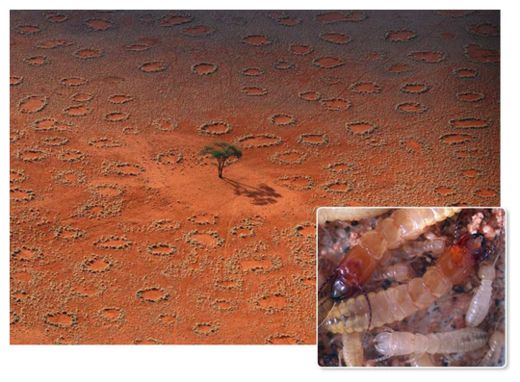
The strange saga of the fairy circles got even stranger last year. That's when Walter Tschinkel, a biologist at Florida State University in Tallahassee, analyzed 4 years of satellite images of the formations in Namibia's NamibRand Nature Reserve. Tschinkel had been intrigued by the circles since first encountering them on a vacation to Africa in 2005. The images revealed that some of the formations arose and others vanished over the 4-year period - the first evidence that they were somehow "alive." Extrapolating from the data, Tschinkel estimated an average "lifespan" of 41 years. But he couldn't figure out what made them. Some suspected that termites were killing the grass from below, but Tschinkel found no evidence that the insects caused fairy circles. Nor did he find anything wrong with the soil itself.
Juergens's search for answers began a year after Tschinkel's. He started traveling throughout Africa in 2006 - including to remote areas in Angola, still reeling from its recent civil war - in search of fairy circles. He became intrigued with the formations after noticing, like Tschinkel, that the mysterious patches seemed to come and go from the landscape. He recorded any signs of animal life that he came across in and around the circles, such as tracks, dung, or nests. He also dug trenches from the center of the circles to the outside in order to find any subterranean organisms that may be lurking below.
During these investigations, which spanned 40 field trips and about 1200 sampled fairy circles, a pattern emerged. Using a process of elimination, Juergens saw that only one species was nearly always present at the fairy circles he visited: the sand termite.
Tschinkel and others may have missed these "extremely clandestine" insects, which seem to "swim" through the sand, Juergens says, leaving only very fine tunnels. Unlike some other termite species, they do not build complex underground galleries, have no aboveground nest, and emerge only occasionally at night. Other researchers could easily overlook the insects' fine tunnels by digging too deeply or forcefully, says Juergens, who focused his efforts a few centimeters to tens of centimeters beneath the surface. Juergens found sand termites or their burrows at the vast majority of fairy circles that he investigated, he reports online today in Science.
Juergens believes that in their tunneling, sand termites damage plant roots and feed on them, slowly forming fairy circles in the process. He found the termites in all of 24 newly forming fairy circles that he examined in Namibia. He's still at a loss as to why the fairy circles eventually "die," but he hypothesizes that competition or predation by ants plays a role.
Juergens thinks that the sand termites - which must maintain body moisture to survive - build and tend to these circles on purpose. Whereas plants quickly suck up the desert's stingy 100 millimeters of annual rain, the fairy circles' bare centers allow the rainwater to seep into the porous, sandy earth, where it remains indefinitely. To quantify this, he stuck humidity probes into a range of depths in the fairy circles' bare centers, where the devices recorded soil moisture over a period of four years. "These bare patches are water traps," Juergens says. "Over the years, I didn't measure 1 hour with less than 5% water at 60 centimeters, which is certainly wet enough to support termite life."
This water sink, he thinks, also promotes the characteristic "luxurious belt" of high grass that often grows around the fairy circles' edges, because it does not have to compete with thirsty neighboring plants. During the rainy season, the termites venture into the surrounding grasslands to feed, and in extreme drought seasons they turn to their belt of high grass for sustenance. These nibblings slowly expand the circles' diameters over the years, Juergens says.
Vivienne Uys, a termite taxonomist at the Agricultural Research Council in Pretoria, says that Juergens's findings on the biology of sand termites are consistent with what scientists know about the species. But she says she needs more evidence to be convinced that the insects create fairy circles. "The link between foraging activity of the termite resulting in the formation of a perfect circle of bare soil is unclear."
Tschinkel agrees. "Juergens has made the common scientific error of confusing correlation - even very strong correlation - with causation," he says. "If Juergens claims termites are killing the grass, he's got to show that they're actually attacking living plants. That's not easy to do, and he didn't do it."
"My view is that fairy circles have little, if anything, to do with termites," agrees Michael Cramer, a plant ecophysiologist at the University of Cape Town. He now has a manuscript in review proposing that fairy circles are the product of natural vegetation patterns resulting from competition for scarce resources. "The only way for this question to be properly answered," he says, "is with more thorough investigations and focused experiments."
Juergens stands by his findings. He also says the termites should be marveled at for far more than their ability to make fairy circles. The formations, he notes, act as small oases not just for their termite creators but also for a diverse assembly of desert fauna. He observed numerous species ranging from insects to birds to mammals - including jackals, springbok, moles, foxes, aardvarks, and others - spending time at the fairy circles, foraging either on termites, the high perimeter grass, or else preying on other species that aggregated there.
All in all, Juergens found 10 to 20 times more biodiversity at fairy circles than in the surrounding desert. "These tiny termites have managed to turn rainfall as little as 50 millimeters per year into a continuous, permanently livable ecosystem," he says. "Identification of this termite as opposed to other candidates behind fairy circles is part of the story, but the more interesting story is that this insect evolved to be a masterpiece of ecosystem engineering."



Reader Comments
to our Newsletter